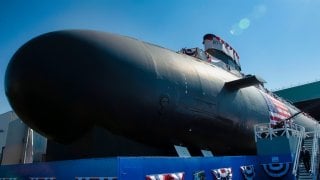To Defend Taiwan, America Needs To Upgrade Its Defense-Industrial Base
All proposed solutions to the deterrence problem on the Taiwan Strait require the United States to modernize and expand manufacturing facilities and infrastructure to increase the production and availability of military hardware.
The ongoing conflicts in Ukraine and the Middle East and the frenzied attempts of the United States and its European partners to quell conflicts in those regions have helped expose an unsettling reality: China now has a closing window of opportunity to take Taiwan by force.
Taiwan's recent presidential election saw the island’s anti-reunification party, the Democratic Peoples’ Party, retain power, beating out the two candidates that Beijing would likely have preferred—and did so despite China’s efforts to interfere in the contest. The result may signal to Beijing that peaceful reunification is a distant possibility that will only grow increasingly unlikely.
Meanwhile, the Chinese Communist Party (CCP) faces deepening economic and demographic issues at home. These trends will, over time, invariably take a toll on the country’s ability to take Taiwan by force. Moreover, China could soon face even stiffer competition from the United States, which has reoriented itself toward “great power competition” with the PRC, and from European nations increasingly wary of the risks of doing business with Beijing.
Nevertheless, China’s government has one major ace up its sleeve: both America and its allies are now deeply preoccupied by events in other portions of the globe. Russia’s ongoing efforts to dominate Ukraine continue to command most of Europe's attention, while Washington has found itself embroiled in the continuing conflict between Israel and Hamas in Gaza. Meanwhile, provocations by Yemen’s Houthi rebels in the Red Sea and assorted Shia militias throughout the Middle East have sorely strained the credibility of American deterrence.
All of which could lead the CCP to believe that it should strike while the United States is spread thin.
Why should we care? First, Taiwan is essential to U.S. national security interests in East Asia, and the United States has both a moral and a strategic interest in preventing China from forcing reunification. The island is a regional bastion of democracy, representing the economic and social success that a democratic China could have achieved. And despite Beijing’s attempts to undermine and discredit democracy there, Taiwan has maintained its unwavering commitment to such values since its first democratic election in 1996.
Taiwan is essential for strategic reasons, too. Taiwan's Semiconductor Manufacturing Company (TSMC) produces 90 percent of the world's advanced semiconductors, which are essential to emerging technology such as artificial intelligence, military encryption, radar, and missile guidance systems. Should China inhibit U.S. access to the semiconductor market—via a blockade or an outright invasion of Taiwan—it would directly threaten our national security.
Moreover, if the United States fails to deter Chinese aggression against Taiwan (or stops short of resolutely responding to it), it would undermine America’s credibility with other allies in the Indo-Pacific. Japan, South Korea, and many others would be left questioning whether the United States would defend them if they faced the same sort of aggression from a belligerent and rising China.
All of this makes the defense of Taiwan an American imperative. Scholars and policymakers have devoted considerable attention to the best way by which Washington can do so, from turning the island into a “porcupine” through a massive infusion of arms to the establishment of a more formal U.S.-Taiwanese military alliance. However, virtually every solution by which the United States can successfully deter Chinese aggression against Taiwan requires another initiative closer to home: a revitalization of the U.S. defense-industrial base in order to enable such support.
Simply put, the United States must modernize and expand its current manufacturing facilities and infrastructure to increase the production and availability of military hardware. Furthermore, it needs to streamline the acquisition process to enable it to sell cutting-edge military equipment to Taiwan in a timely manner. Currently, some $19 billion in defense deliveries to Taiwan remain delayed—a state of affairs that surely has an emboldening effect on China’s calculations. Finally, America needs to prioritize efficacy over cost. As we’ve seen in Ukraine, inexpensive drones can provide battlefield advantages that more cumbersome—and costly—packages cannot. That should be a consideration when it comes to the defense of Taiwan as well.
To its credit, Congress is aware of the problem. In recent years, at least two initiatives—the Taiwan Policy Act of 2022 and the Taiwan International Solidarity Act of 2023—have attempted to strengthen the reliability of the weapons pipeline from Washington to Taipei. But both measures have stalled on Capitol Hill, casualties of political squabbles and partisan considerations. And, while the National Defense Authorization Acts for Fiscal Years 2023 and 2024 do include provisions relating to military aid, joint training, and cybersecurity cooperation, they fall far short of the support necessary for Taiwan to be truly secure.
That makes Taiwan a key election-year priority. While both President Biden and his Republican challenger, Donald Trump, have backed the necessity of strategic competition with the PRC, neither has so far said much about ramping up our defense-industrial base to do so. They should because, regardless of who wins the next election, Taiwan will remain on the front line for Chinese expansion.
About the Author
Walker Robinson is a researcher at the American Foreign Policy Council in Washington, DC.
Image: U.S. Navy Flickr.


